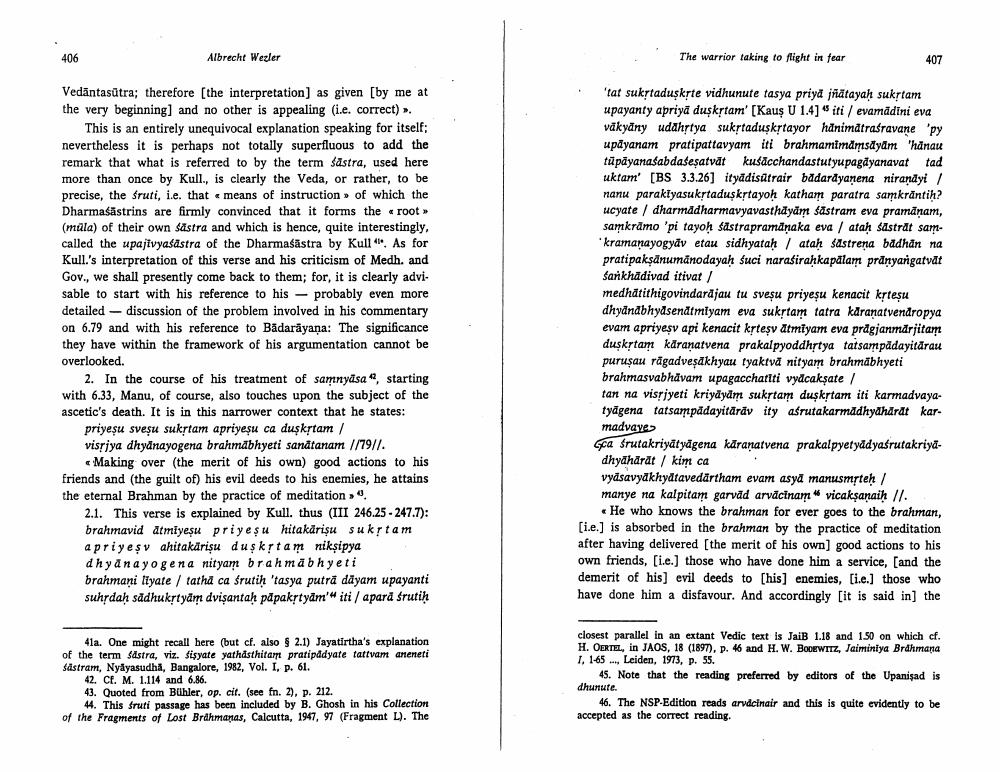________________
406
Albrecht Wezler
The warrior taking to flight in fear
407
Vedāntasūtra; therefore the interpretation) as given [by me at the very beginning) and no other is appealing (i.e. correct).
This is an entirely unequivocal explanation speaking for itself; nevertheless it is perhaps not totally superfluous to add the remark that what is referred to by the term Sastra, used here more than once by Kull., is clearly the Veda, or rather, to be precise, the fruti, i.e. that means of instruction of which the Dharmaśāstrins are firmly convinced that it forms the root (múla) of their own sastra and which is hence, quite interestingly, called the upajivyaśāstra of the Dharmaśāstra by Kull". As for Kull.'s interpretation of this verse and his criticism of Medh, and Gov., we shall presently come back to them; for, it is clearly advisable to start with his reference to his – probably even more detailed - discussion of the problem involved in his commentary on 6.79 and with his reference to Badarāyana: The significance they have within the framework of his argumentation cannot be overlooked.
2. In the course of his treatment of samnyāsa, starting with 6.33, Manu, of course, also touches upon the subject of the ascetic's death. It is in this narrower context that he states:
priyeșu svesu sukstam apriyeșu ca duşkstam / visriya dhydnayogena brahmabhyeti sandtanam //79/7.
« Making over (the merit of his own) good actions to his friends and (the guilt of) his evil deeds to his enemies, he attains the eternal Brahman by the practice of meditation
2.1. This verse is explained by Kull. thus (III 246.25 - 247.7): brahmavid Atmiyeșu priye şu hitakarişusuktam apriyes v ahitakārişu duşkštam niksipya dhyanayogena nityam brahmabhyeti brahmani tiyate / tatha ca śrutih 'tasya putrā dāyam upayanti suhrdah sadhukrtyam dvişantah papakrtyam' iti / apard śrutih
'tat sukstaduşkpte vidhunute tasya priya natayah sukstam upayanty apriyā duşkstam' (Kaus U 1.4] " iti / evamadini eva vakyany udahrtya sukstaduskrtayor hanimatrastavane 'py upāyanam pratipattavyam iti brahmamimamsayām "hānau tüpāyanasabdašeşatvāt kusacchandastutyupagdyanavat tad uktam' [BS 3.3.26] ityādisātrair badardyanena nirandyi / nanu paraklyasukstaduskatayoh katham paratra samkrantih? ucyate / dharmadharmavyavasthayām sastram eva pramānam,
samkrāmo 'pi tayoh sastrapramanaka eva / atah sastrat sam'kramanayogydy etau sidhyatah / atah sastrena badhan na pratipakşdnumānodayah suci narasirahkapalam pranyargatvat Sankhādivad itivat / medhatithigovindardjau tu svesu priyesu kenacit krtest dhydnabhydsendtmiyam eva sukstam tatra karanatvendropya evam apriyesv api kenacit kşteşv atmiyam eva prdgjanmarjitam duskrtam karanatvena prakalpyoddhrtya tatsampadayitārau puruşau ragadveşakhyau tyaktva nityam brahmabhyeti brahmasvabhavam upagacchatiti vydcakşate / tan na visriyeti kriydydm sukstam duşktam iti karmadvayatyāgena tatsampādayitārāv ity aśrutakarmádhydhardt karmadvave Gca frutakriyātyāgena karanatvena prakalpyetyddyasrutakriyadhyānārdt / kim ca vyāsavyakhydtavedärtham evam asya manusmrten / manye na kalpitam garvad arvācinam vicaksanaih Il.
• He who knows the brahman for ever goes to the brahman, [i.e.) is absorbed in the brahman by the practice of meditation after having delivered the merit of his own) good actions to his own friends, [i.e.) those who have done him a service, and the demerit of his] evil deeds to [his] enemies, [i.e.) those who have done him a disfavour. And accordingly [it is said in) the
Lai cao
41a. One might recall here (but cf. also $ 2.1) Jayatirtha's explanation of the term Sastra, viz. Sisyate yathasthitarrt praripddyate tattvam anteneri sastram, Nyayasudha, Bangalore, 1982, Vol. I, p. 61.
42. Cf. M. 1.114 and 6.86. 43. Quoted from Buhler, op. cit. (see fn. 2), p. 212.
44. This sruti passage has been included by B. Ghosh in his Collection of the Fragments of Lost Brahmanas, Calcutta, 1947, 97 (Fragment L). The
closest parallel in an extant Vedic text is JaiB 1.18 and 150 on which cf. H. OERTEL, in JAOS, 18 (1897), p. 46 and H. W. BOOKWITZ, Jaiminlya Brdhmana I. 1-65 ... Leiden, 1973, p. 55.
45. Note that the reading preferred by editors of the Upanişad is dhunute.
46. The NSP-Edition reads arvdcinair and this is quite evidently to be accepted as the correct reading.




